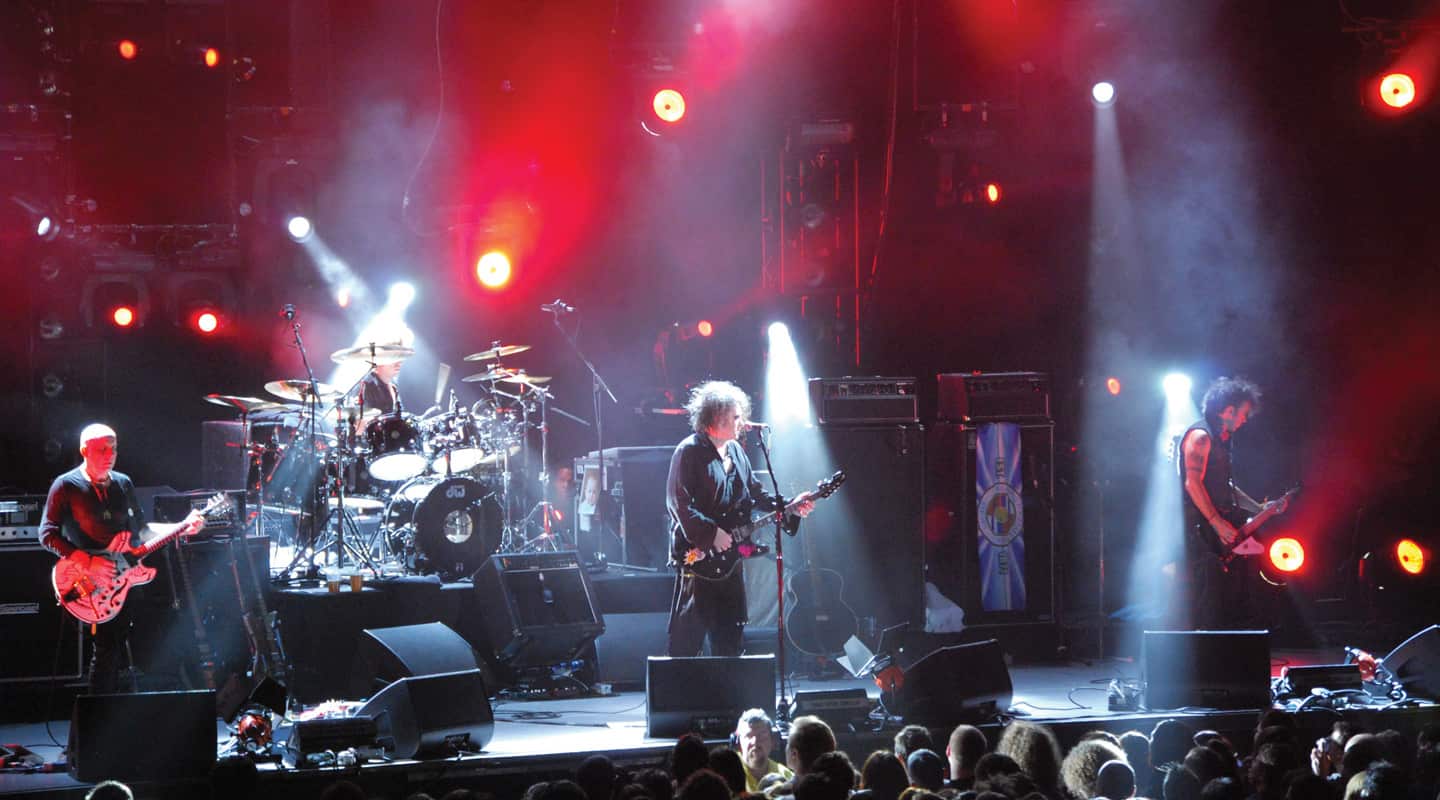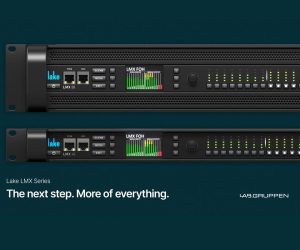
The Cure Live
If the 2007 tour is anything to go by, after 30 years, The Cure’s prognosis is good.
Text: Christopher Holder
The Cure’s iconic frontman, Robert Smith, is one of the instantly recognisable faces in pop. Actually, to be more specific, Robert Smith has one of the most instantly recognisable hair-dos in pop. Some 30-plus years in the biz, changing fashions, and an alarming hole in the ozone layer, haven’t made a dint on Robert’s love affair with Cedel hairspray.
But whatever preconceptions you might have had about Robert Smith – you could be forgiven for thinking he was more worried about his mascara than his vocal tone – would probably be confounded after a chat with The Cure’s FOH and monitor engineers, Michael Brennan and Rob Elliot.
Rob Elliot (Monitors): “Robert’s got an amazing ear and he’s very hands on. The other day I touched something in the vocal channel, and straight away he’s like – ‘what did you do? Put it back, it doesn’t sound as good now’. And we’re talking about maybe 1dB at 500Hz!
Michael Brennan (FOH): “And he’ll call frequencies all the time: ‘Less 300. Widen the Q a little bit… that’s it. Yeah. I’m getting too much 3.5k’.”
And then there was the time Rob and Michael gave Robert Smith a Sennheiser 935 vocal mic to audition, possibly to replace the Shure SM58 he’d used for decades.
Michael Brennan: “It was a lovely sound, and he acknowledged that, but he’s so used to the sound of the 58, and he likes the growl he gets off the 58. You can’t argue with Robert Smith, he’s been doing it a long time.”
Rob Elliot: “Right. And the other factor was that the flat basket of the 935 rubbed his lipstick off too quickly… unlike the round ball of the 58!”
Perfect. That just about sums up Robert Smith – the creative force of The Cure. A musical perfectionist? Yep. Vain? Well… maybe just a bit!
77 SONGS – TWO WEEKS REHEARSAL
Just prior to the current world tour, Robert Smith spotted FOH Engineer, Michael Brennan, mixing Mogwai in the UK. Apparently he liked what he heard and offered him the tour. Two weeks of production rehearsals followed.
Christopher Holder: Can you tell us about those initial preparations, Michael?
Michael Brennan: We set the band up in an enormous sound stage on a film studio lot. The band was in one room and I was in a smaller room with my [Digidesign] Venue console, three L-Acoustics ARCS cabs and two 218 subs.
Initially it was simply a case of getting a sound up on the board. I’d record the rough mix in ProTools, Robert would listen and then we’d discuss it and tweak it. We’d repeat that process until Robert was like, ‘fundamentally that’s what I want’. And then it’s been a case of putting the icing on that sound – fine-tuning it.
CH: How many songs did you prepare?
MB: Seventy-seven. He would call a new set-list each day!
CH: Woah. It sounds like Robert knows what he wants. Does that extend to keeping an eye on how the sound progresses during the tour?
MB: We record a mix of the show every night, and he’ll listen to my mix and we discuss it the next day: ‘In the Middle 8 of Forest, do you think the guitars are eating up my vocal a little bit?’ Stuff like that. He’s also very concerned about the stereo image. We’ve got a lot of stereo things happening up there and the width of the songs is very important to him.
CH: What sort of elements?
MB: Porl [Thompson] has two guitar cabs going with two mics on each – he’s panned about ‘10 & 2’. Robert’s acoustic guitar has three lines, which are set wide left and right and a centre, which fills out the sound. He got me to pull the left and right lines in to a ‘9 & 3’ position because he figured that’s where they should sit… and sure enough, he was right – it sounds better.
This is only our eighth or ninth show and I know we’re miles ahead, sonically, from where we were last week




CONTROL FREAK
CH: Would you describe yourself as a relaxed operator or do you need to know precisely what’s going on all the time?
MB: I’m a control freak, no question. I’m listening and constantly tweaking – not crazy stuff, just massaging levels. And I just can’t stop thinking about everything all the time… Where everything’s routed, system EQ… I’m the only person that knows how it should be sounding, really. I wish I had a USB connection in my skull to download it!
CH: Which brings us neatly to the console. Sounds like a digital console like the Digidesign D-Show suits your style?
MB: Well, there’s no question that each night I’m making changes and refining the sound – making improvements then saving them as snapshot updates. What I’m doing is still within Robert’s production rehearsal parameters, but I can hear and improve the sound every night. This is only our eighth or ninth show and I know we’re miles ahead, sonically, from where we were last week in Perth. Even the difference between the first and second shows in Sydney was, for me, massive. The second night was smoother – I EQ’d the system a bit more, produced it a little bit more.
CH: And I notice there’s not much in your rack, so you’ve obviously explored the on-board plug-ins?
MB: I have. The console came supplied with something called an Access Pack, which meant the dongle was loaded with hundreds of plug-ins. And at one point it seemed like I had every one of them loaded up. But then I decided, ‘hang on, I don’t need this’, and I stripped things back again. But, for example, on vocals I’ve got a Line6 Echo Farm, Focusrite d2 mono EQ and a Fairchild 660 compressor. The Fairchild compressor is something I just stumbled on while exploring the plug-ins and it’s fabulous on Robert’s voice.
CH: No misty-eyed nostalgia about running racks of outboard compressors and preamps then?
MD: I’ve tried a lot of external compressors and preamps on this tour. I’ve tried Ameks, Klark Tekniks, Avalons, and they all do nice things, but there’s no point; I’m getting everything I need from the board. That’s the beauty of the D-Show: I can go wherever I need to go, hire a board locally, put my mix in, and I’ve got everything I need… I don’t need any external processing. And you’re up and running, ready to roll. And because each time you’re using the same console, configured in the exact same way, your mix is constantly improving.

SUBS OFF AN AUX SEND?
While Michael was showing me around the D-Show’s matrix section he made an almost throwaway comment that struck me as interesting (“I’ve got the subs on an auxiliary – the system sounds better like that”). A bit later I had to haul him up. And sure enough, the subs don’t get a matrix send, they get a ‘mix’, which allows Michael to pick and choose what he sends.
MB: The first few gigs I wasn’t doing it that way and the subs were restricting me, they were deciding where I could go with the mix. Now I’ve got all of my main mix coming out the V-DOSC, and the subs are on a separate dial via an aux on every channel. So we’re not restricted with where we can go with the V-DOSC. It has made a massive difference. It gives me a lot of headroom.
CH: I think you’re going to have to elaborate Michael.
MB: Okay. Previously, when the subs were part of the main mix, the V-DOSC went down to about 60Hz. Now I’ve taken the V-DOSC right down to 30Hz and I’ve kinda butchered the EQ on the low end of the V-DOSC so it sounds really tight and sweet. And I’ve butchered the subs as well, so they sound fat – providing proper subsonics. It’s really tightened the sound of them. To be honest, if I turn the subs off, there’s still enough bottom end there. But the subs give it the extra warmth. You feel it more than hear it.
CH: But why couldn’t you do that with the subs being fed from a matrix send as per usual?
MB: If it’s on a matrix send you’ve got every channel going to the subs all the time. And because of that you find yourself filtering loads of channels to stop certain channels’ low end going to the subs and unnecessarily using up the subs’ headroom. But now, I don’t need to filter the channels, I can leave them as flat as I want – keeping all that warmth and body and tone. Once you start filtering it exposes other stuff. And you have to start EQ’ing top end as well, because you’ve taken out the entire bottom, which covers up that harshness. Before you know it, you’ve lost all your tone and you start to push faders to +6… and then you’re really chasing your tail. This way, I can adjust the subs constantly from song to song – using the subs creatively.


ENCORE ENCORE
A Cure concert takes the audience through the full gamut of emotions – sadness, depression, fear, angst, hopelessness… Just kidding. It was a top-quality exhibition of four musicians right on top of their game and a full Rod Laver Arena showed their appreciation. Having some 77 songs prepared really is quite extraordinary, and evidently Robert Smith and the band take their craft very seriously. Which, as I mentioned earlier, may have confounded some expectations. But looks are often deceiving, as Michael Brennan clearly illustrated with this final anecdote:
Michael Brennan: I was on a tour with The Ramones – the very last tour of The Ramones in America – and I had a meeting with the band every night after the show. And every night I was thinking – ‘you’re the f***ing Ramones, why do you even care!?’ But sure enough, they went through every song with me – dissecting the sound. But, I’m not complaining, it’s good that a band cares.
















RESPONSES